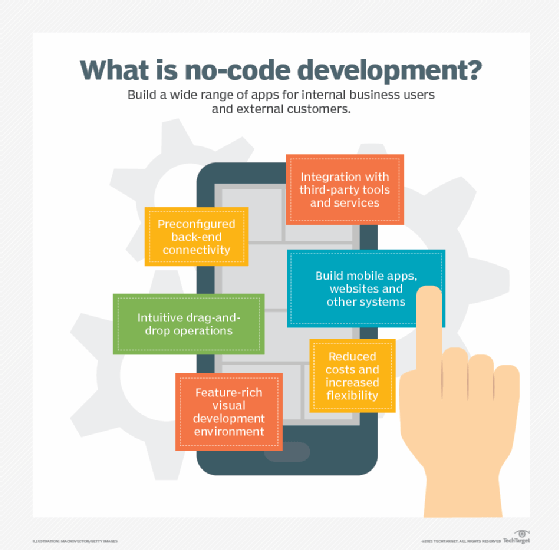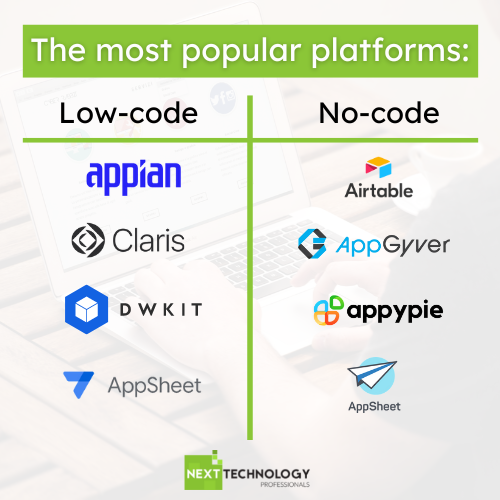Top Tips To Selecting Low-Code Platform Examples
Top Tips To Selecting Low-Code Platform Examples
Blog Article
Benefits Of Low-Code Application Development In Terms Of Accessibility For Non-Developers
Low-code application development significantly improves accessibility for non-developers. Often, they are called "citizen developers," because of a variety of key factors. Intuitive Visual Interfaces:
Drag-anddrop Builders: Lowcode platform provide drag-and-drop interfaces, which let non-developers create visual applications, without having to codes. The process of developing applications is now more accessible to those who have no technical background.
WYSIWYG editor: "What you see is the result you get" editors let users design interfaces, workflows, and other functions in a manner that is similar to the final product. They are easy to comprehend and use.
Simplified Workflow Design and Logic Design
Visual Workflow Modeling - Users are able to develop business processes and logic for applications using visual flowcharts or models. This is much more simple than traditional programming methods.
Pre-built Components for Logic: Low-code platform often includes already-built logic (e.g. loops, conditional statement) which can be easily configured, reducing a requirement for complicated programming.
Reusable Components & Templates
Libraries of prebuilt templates: Low-code platforms usually offer libraries of templates for the most popular types of applications. This gives non-programmers the opportunity to start with a solid basis and modify it as needed.
Reusable widgets and modules: The creation of websites is made easier by using reusable components and modules. This reduces the necessity for a deep technical understanding.
Guided Development and Tutorials
Step-by-step guide Platforms offer tutorials, tips on screen, and guided development paths to assist non-developers in creating applications.
Interactive Tutorials. Interactive, hands-on tutorials allow users to learn through doing.
Integration with existing tools:
Seamless Integration: Low-code platforms are built to integrate seamlessly with the tools and systems in business (e.g. the CRM or ERP), which lets non-developers to develop applications that work with current workflows.
APIs/Connectors: These APIs/Connectors make it easy for non-developers connect their applications to other services.
Collaboration Features:
Team Collaboration: real-time collaboration, shared workspaces and shared workspaces permit business analysts, non-developers, and other stakeholders to effectively work with professional developers.
Role-Based Access Control: Non-developers are assigned roles, with the appropriate access levels, which ensures they can contribute to the process of development without having to compromise security and functionality.
Automated Testing & Debugging
Low-code platforms usually come with an integrated testing and debugging tools which automates this process. Non-developers are now able to ensure their application works correctly.
Error Highlighting: If problems arise the platform highlights any errors and suggests fixes and guides non-developers through troubleshooting steps.
The capability of low-code apps to make development accessible to non-developers is their biggest benefit. With its an intuitive, visually-guided tool and experiences, low-code platforms let business owners actively contribute and manage applications. Check out the top helpful resource about Low-code Platform for application development for website info including rapid app development, microsoft azure sql, app development platform, develop web app, low code platforms, no code platforms, develop web app, app dev platform, rad application development, azure sql server and more.
The Advantages Of Developing Low-Code In Terms Of Flexibility, Scalability And Scalability
Low-code development of apps offers many advantages, including scaling and flexibility in design of the application. These are crucial in creating apps that adjust to the changing demands and expand with the needs of the business. Here are the main benefits: Rapid Scaling:
Cloud-based deployment: A lot of lowcode platforms are based on cloud computing, which allows applications to grow with the underlying infrastructure. This allows businesses handle increased workload without having to manage servers.
Auto-Scaling Functions: Auto-scaling functions can be used to adjust resources automatically according to demand. They make sure that performance is consistent in peak hours.
Flexible Architecture:
Modular Design: Low code platforms encourage modularization of applications, allowing components to be designed independently, tested and scalable. This is a fantastic method to improve flexibility. It can also be used to update and expand parts of a system without having the entire application affected.
Microservices Integration Microservices support allows applications to be developed as a set of loosely coupled services, enhancing the scalability as well as flexibility.
Customizable Solutions
Extensibility Low-code platforms typically permit custom programming and scripting. This lets developers extend applications' functionality beyond what is available out of the box. This enables unique business requirements to be met with no limitations.
Third-Party Integrations: The capability of companies to integrate APIs and third-party apps and add new functions to the application as needed, increases its capabilities.
Agile Development and Deployment
Continuous Delivery and Deployment : Low-code platforms can support agile methodologies that allow continuous integration and continuous delivery (CI/CD). This lets applications be updated and upgraded quickly as a result of feedback from users.
Iterative Devlopment: Due to the iterative nature low-code software can grow and evolve incrementally. This minimizes risks associated with major changes and allows for more controlled expansion.
Resource Optimization
Efficient resource management: Platform tools that use low-code help optimize resource use by monitoring and managing the performance of software. This ensures that resources are being used effectively. They are also able to be scaled-up or down in accordance with the actual requirements.
Load Balancing : The integrated load balancing function distributes workloads equally among servers. This increases the application's capacity to handle the demands of high traffic and also ensures consistent performance.
Global Reach:
Multi-Region deployment: Low-code systems can often support deployment across multiple regions. This allows businesses to provide low-latency services to users from all over the world. This is crucial, particularly for applications that serve global users.
Localization: Support for localization is integrated into the software, allowing applications to be easily modified to accommodate various languages or regional needs. This enhances flexibility for various markets.
Updates and maintenance
Simplified Maintenance: The graphic and modular nature of low-code programs simplify maintenance tasks which allows upgrades and bug fixes to be completed quickly and without lengthy downtime.
Version Control Version Control: Systems that integrate version control oversee rollbacks and changes in order to make sure that upgrades are safe to be made and that older versions are restored when needed.
Cost Efficiency:
Low-code platforms cut down on development costs by reducing the need for extensive code. They can also allow you to expand applications without significant expenditure or effort.
Pay-As-You-Go Models: Many low-code platforms provide flexible pricing models, such as pay-as-you-go, which align costs with use and growth, offering the flexibility to finance.
Overall the scalability and flexibility benefits of low-code development allow businesses to create robust, adaptable, and scalable applications efficiently. These platforms enable rapid adjustments to the demands of changing markets and efficient utilization of resources and continual advancement. Applications can grow and change with the business. View the best she said about Enterprise application development with Low-code Platform for website recommendations including app dev platform, low code platforms, develop web app, multiplatform mobile app development, lowcode no code, app development platform, database in azure, no code platforms, rapid action development, database in azure and more.
Benefits Of Low-Code Application Development In Terms Of Customization And Constraints
Low-code app development is a well-balanced solution that has significant advantages in dealing with limitations and providing the ability to customize. These are the main benefits: Handling the limitations
Overcoming Complexity:
Simplified Development: Low-code platform reduces complexity by providing components and templates that are pre-built, allowing rapid development and deployment.
Many platforms have guided workflows, which assist developers navigate their way through the complex processes. They minimize the risk of error and maintain uniformity.
Scalability Solutions:
Scalability is built in: Low-code platform often includes capabilities that permit the development of scalable architecture. Applications can handle increased demands with little redevelopment.
Performance Monitoring: The tools that monitor and optimize performance can help ensure that applications are efficient, even when they grow.
Security and Compliance:
Security features integrated into Low-code platform comes with built-in measures of security such as encryption. Access control that is based on roles and automated compliance checks to address the most prevalent security concerns.
Platforms regularly update their security protocols, and ensure that they are in compliance with the regulatory requirements. This helps keep platforms safe from new threats.
Capabilities to Customize:
Extensibility:
Low-code platforms let developers enhance functionality beyond the standard offerings by integrating custom code.
Custom Plugins and Moduls: Developers may develop custom plug-ins and modules that have specific features tailored to the unique requirements of a business.
APIs and integration
API Support. A comprehensive API support enables seamless integration between other systems and services, allowing extensive customisation and connection.
Third-Party Services : Low-code platforms often provides pre-built connections for popular services provided by third-party providers, making integration and customization easy.
Flexible UI/UX design:
Customizable Interfaces Developers are able to design and customize user interfaces in line with specific usability and branding criteria and create a personalized user experience.
Responsive Design: Built-in adaptive design capabilities mean that apps can be tailored to fit different sizes of screens and devices.
Custom Business Logic:
Visual Workflow Builders This tool lets developers develop complex processes using little or no coding. They are able to design business processes and workflows visually.
Platforms come with conditional Logic, which allows for the creation of custom scripts that address particular scenarios and business rules.
Data Management:
Custom Data models: Developers have the ability to design a custom data model to satisfy specific requirements of an application and make sure that data handling complies with business needs.
Advanced Data Processing: Integration of advanced tools and capabilities to process data permits customizations to the way data is analyzed within an application.
Balancing Limitations with Customization:
Frameworks and Standards
Low-code platforms conform to the industry standard and best practice. This allows for the highest quality and security of applications.
Governance Frameworks Inbuilt governance frameworks will ensure that any modifications do not interfere with the integrity, security or security of the application.
Iterative Development:
Rapid Prototyping. The ability to speedily prototyping and testing modifications allows developers to tweak the application based on the feedback of users. This helps to refine the app to better meet users' needs.
Continuous Improvement: Low code platforms enable constant improvements. They can be customized and enhanced as business needs change.
User Empowerment
Empowering Citizen Entwicklers by giving non-developers the ability to customize their applications through simple interfaces as well as low-code platforms they can increase the number of contributors who are able to improve and modify the application.
Support and Training Information: Many platforms offer an extensive set of training and support resources to help users customize applications without compromising their stability or performance.
In general, low-code application development is a strong system to overcome weaknesses and provides a wide range of options for customization. This balance lets businesses create and maintain functional apps designed to meet their requirements while maintaining high standards for quality, security and the ability to scale.